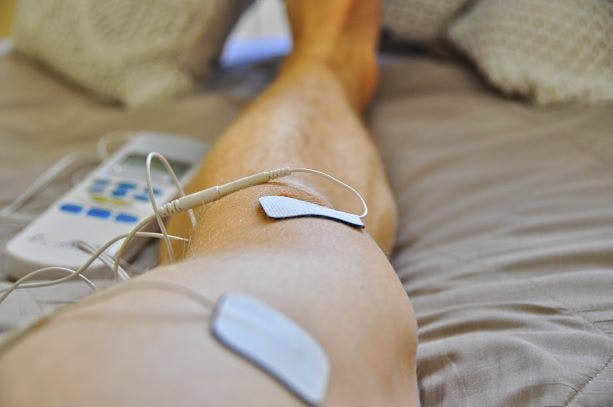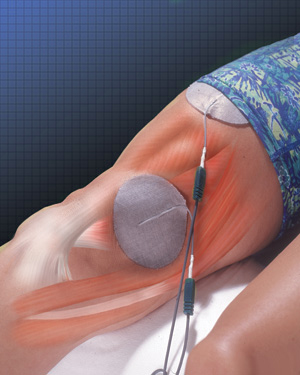The success of your knee replacement surgery depends on how you progress during your rehabilitation. In particular, the first few weeks of physical therapy are essential for your long-term success. This is because the function of your quadriceps muscle on the front of your thigh is one of the biggest predictors of long-term success. Neuromuscular electrical stimulation to your quadriceps is a proven way to speed up your recovery after knee replacement surgery.
Quadriceps Muscle Loss after Knee Replacement
Weakness and atrophy of your quadriceps are common after knee replacement surgery. Pain and swelling in your knee result in your quadriceps muscle shutting down. Your brain is responsible for this reflex. However, the longer you allow this, the longer and harder your recovery will be.
Research is now showing that early restoration of quadriceps muscle strength is crucial if you want to have a successful outcome one year after your surgery. Using neuromuscular electrical stimulation alongside your strength training exercises results in the best outcomes.
What is Neuromuscular Electrical Stimulation?
Neuromuscular electrical stimulation (NMES) uses electrical current to facilitate muscle contraction. Your physical therapist places pads (also known as electrodes) on the skin over your quadriceps muscle. The placement of the pads is important to activate certain portions of your muscle. The pads connect to an electrical stimulation unit. Some units are small, portable, and battery-powered. Other larger units in a physical therapy clinic require power from an electrical outlet. Larger units produce electrical currents at greater intensities.

Your physical therapist will adjust the intensity of your treatment. In general, the higher the intensity the more effective the electrical stimulation is. Expect some discomfort. You will perform an isometric muscle contraction while the stimulation is on. This means your muscle will contract but no movement will occur at your knee. The contraction lasts for 5 to 10 seconds. Then, you rest for a period of 15 to 50 seconds. You will perform a total of 10 to 15 maximum-intensity contractions each session.
Ideally, NMES is administered daily. On the days you attend physical therapy, you will receive treatments as part of your exercise program. Also, if a portable unit is available, you will be asked to complete the same protocol at home during the other days. With each treatment, increase the intensity of the electrical stimulation. This will recruit a greater number of muscle fibers.
3 Benefits of Using Neuromuscular Electrical Stimulation

Neuromuscular electrical stimulation restores quadriceps muscle function quicker after your surgery. This is also associated with greater strength 1 year after surgery compared to people who do not receive the treatment. These improvements in strength are linked to improvements in your functional abilities such as walking and climbing stairs.
- Improved Walking Speed. A 2003 study from the United Kingdom looked at walking speed over 3 minutes in patients who received NMES after surgery. They compared these results to patients who did not receive the NEMS treatments. Patients who received NMES resulted in 3 times the improvement in walking speed compared to patients who did not. This was evident 6 weeks and 12 weeks after surgery.
- Improved Walking Distances. A 2012 study from the University of Colorado looked at walking endurance over a 6-minute period. Sixty patients recovering from knee replacement surgery completed an intensive strengthening program immediately after surgery. Half of the patients also received daily NMES to their quadriceps. One year after surgery, patients who received NMES were walking about 10% further than those who did not receive NMES.
- Improved Stair Climbing. The same study also looked at the patient’s ability to climb a flight of stairs. One year after surgery, patients who received NMES were climbing stairs 20% faster than those who did not receive NMES. Climbing stairs, along with many other functional tasks, is highly dependent on the strength of your quadriceps muscle.
How to Get Started with Electrical Stimulation after Knee Replacement
Recovering from your knee replacement is not easy. This is especially true during the first 2 to 4 weeks. However, this is the most important time of your recovery. Your priorities are to minimize pain and swelling, restore range of motion, and get your quadriceps muscle firing.
Our experience, and the research evidence, suggest regaining the function and strength of your quadriceps muscle is the most important. Incorporating neuromuscular electrical stimulation into your rehabilitation will expedite your early recovery. It will also help you achieve a better long-term outcome. Contact us if you are ready to get started with your post-knee replacement rehab.


